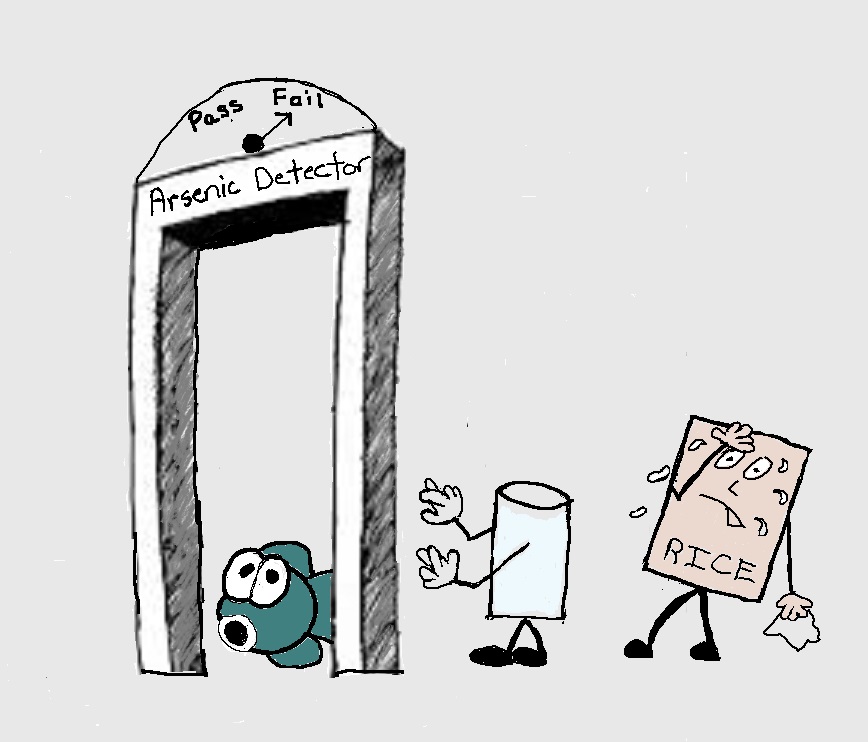- Home
- Toxic Chemicals & Health
- Cause of Diabetes Type 2
A Shocking Cause of Diabetes Type 2 You Need To Know About
There are several well known causes for the dramatic increase in people with diabetes over the past 20 years. And there is one shocking, little known cause of Diabetes Type 2 you need to know about.
Do you eat lots of canned foods? Love rice, especially brown rice? Believe full-fat dairy is the only way to go?
Do you reach for a can of Raid every time you see a bug? Or maybe you're a fragrance fanatic. Your house smells like a field of lavender, your clothes like an ocean breeze and your hair like rosemary.
Did you nod yes to any of these questions? If so, you really need to read this article. Because you are voluntarily increasing your risk of getting Diabetes Type 2!
You probably already know that lifestyle factors like lack of exercise, a carb rich diet, smoking and being overweight, plus a genetic predisposition, can cause diabetes type 2. BUT, did you know that there is rapidly accumulating evidence that your increasing exposure to endocrine disrupting chemicals (EDCs) also contributes to the rise in this disease.
According to the U.S. National Institute of Environmental Health Sciences/National Toxicology Program (NIEHS/NTP) database by 2011 there were over 200 human studies linking EDCs to diabetes and obesity. And the evidence has been growing since then.
In other words, a cause of Diabetes Type 2 you’ve probably never heard of is your frequent exposure to EDCs like BPA, numerous types of phthalates and persistent organic pollutants (POPs).
A Cause of Diabetes Type 2 - EDC Exposure
The CDC estimates that 9.3% of the U.S. population has diabetes. And a group of chemicals called endocrine disruptors are contributing to the increase in this disease worldwide.
EDCs are chemicals that mess with your endocrine system, a group of glands in your body that secrete hormones. These hormones control metabolism, growth and development in tissue, sexual and reproductive functions, sleep, and mood among other physiological changes.
EDCs are a structurally diverse class of synthetic and natural compounds that can alter the way your endocrine system functions and potentially cause adverse health effects. Currently, about 800 chemicals that are being used in daily life possess endocrine disrupting properties.
And that's scary because all endocrine organs are vulnerable to endocrine disrupting chemicals because of the hormones they release and respond to. EDCs block your body’s natural hormones from going where they need to go. This means your hormones can’t do their job.
Endocrine disruptors also take the place of your natural hormones, setting off similar chemical reactions in the body. They can even mess with your hormone levels or change the way hormones move throughout your body.
Diabetes Type 2 is a disease where your blood glucose levels are above normal. When you have diabetes, your body either doesn't make enough insulin or can't use its own insulin as well as it should.
And insulin is a hormone produced by the pancreas, which is part of the endocrine system. Insulin decreases blood sugar levels by helping your cells take in and use glucose and by preventing the breakdown of glycogen into glucose.
Because it's a hormone it's a prime target for endocrine disrupting chemicals. This is why exposure to EDCs that interfere with insulin production is a cause of Diabetes Type 2.
EDCs That Cause Diabetes
There are approximately 800 known EDCs. And unfortunately they are found in plenty of everyday products (including plastic bottles, metal cans, toys, cosmetics, air fresheners and pesticides). And they’re used in the manufacture of food.
Some researchers believe there are many EDCs
capable of causing diabetes that have yet to be identified. But currently, the
endocrine disruptors with the most evidence linking them to diabetes are
arsenic, BPA, some pesticides, phthalates and some persistent organic
pollutants.
Arsenic
Arsenic is a naturally occurring chemical element. It enters soil and water from the erosion of rocks, volcanic eruptions, contamination from mining and the use of this chemical as a preservative in wood products and as pesticides.
The reason you’re exposed to arsenic is that it does enter soil and water. The same soil that food grows in (plants absorb arsenic through their roots) and the same water that could end up coming out of your tap.
And arsenic exposure through your drinking water and food is a cause of diabetes type 2. In fact, a 2013 study found that for every 15 mg/L (milligrams per liter) increase in arsenic concentration in drinking water, the risk for diabetes increased by 27%.
To Reduce Your Exposure
- Choose a water filter that removes arsenic.
- Replace rice in your diet with low arsenic grains like farro and quinoa, especially brown rice and anything made with brown rice.
BPA
Bisphenol A, or BPA is an industrial chemical used to make polycarbonate plastic and epoxy coatings. BPA mimics estrogen in your body. So for a brief time in its disturbing history it was also considered for use in estrogen-replacement therapy!
Because it now lines most of the 131 billion food and beverage cans made in the U.S. annually and is common in plastic food containers, the main way you are exposed is through your diet.
Tests have reported the highest levels are found in canned foods. Drinking water from polycarbonate plastic bottles and using plastic to prepare meals can also expose you to a hefty dose.
Even though BPA breaks down quickly in your body, you are constantly exposed. And even exposure to small amounts can disrupt your hormones. That’s a problem.
Because according to a 2016 review of human clinical studies, there is a positive link between BPA exposure, evaluated by measuring the BPA levels in urine, and the risk of developing type 2 diabetes. BPA, even at low doses, acts on your pancreatic cells to impair insulin and glucagon secretion.
To Reduce Your Exposure
Since about two thirds of your exposure to BPA and BPA Free substitutes comes from food packaging, you can greatly reduce your exposure by avoiding food and beverages packaged in plastic and cans.
- Go can free. It takes a little effort but if I can do it, you can too. Click here for can-free strategies.
- When buying condiments, dressings and things like nut butters and applesauce, chose brands in glass containers.
- Avoid drinking water from plastic bottles. Filter your water at home and use stainless steel or glass containers to drink from.
- For storing and heating food, glass is the only way to go.
- Don't use BPA-free plastic. Studies have found many BPA substitutes are as bad or worse for you than BPA.
Pesticides
Fifty six different pesticides are considered known or suspected endocrine disruptors. And quite a few of them are thought to be a cause of diabetes type 2.
For example, a 2016 research review found 22 studies on pesticide exposure and type 2 diabetes. They concluded from an analysis of these studies that there is a link between organochlorine insecticide exposure and insulin resistance and type 2 diabetes. Organochlorines are also POPs (see next section) and the types linked with diabetes include heptachlor, HCB, DDT, and trans-nonachlor (a component of the pesticide chlordane).
Organophosphate insecticides are also linked to diabetes. These insecticides are commonly used in agriculture and home gardening. Examples of organophosphates include the following: malathion, parathion, diazinon, fenthion, dichlorvos, chlorpyrifos, ethion.
Pyrethroid insecticides, which are synthetic chemical versions of pyrethrins derived from chrysanthemum flowers, may also be linked to diabetes type 2. Pyrethroids are common in household insecticides and pet products and are used for mosquito control.
And many of them disrupt your endocrine system. Examples of endocrine disrupting pyrethroids include allethrin, resmethrin and permethrin.
Atrazine, a triazine herbicide that is the second most commonly used weed killer on farms, is also a possible cause of diabetes because it promotes insulin resistance.
To Reduce Your Exposure
Endocrine disrupting pesticides are found in the food you eat and the water you drink. You're also exposed when you use pesticides in your home and yard.
- Eat organic food, especially for the produce with the most pesticide residues.
- Use natural plant-based insecticides in your home and garden.
- Use natural, plant-based herbicides to kill weeds.
- Invest in a good water filter.
Phthalates
There are about a dozen different types of phthalate compounds commonly used in everyday products. Some types are added to plastics to make them pliable. And since they're not chemically bound to the plastic and other products, they evaporate into your indoor air. So one way you’re exposed is by inhaling them.
They are also used to enhance fragrance chemicals. In fact, some of the highest levels of phthalates in indoor air come from scented products. They are used in these products to stabilize the fragrance.
Phthalates are also used as solvents and to increase spreadability and enhance absorption in personal care products. When you use these products, phthalates can be absorbed into your skin
You also ingest them because they are found in some of the food you eat and also bottled water. Phthalates have been reported as one of the major components of food packaging materials. That's probably why particularly high levels have been found in fatty foods.
And you're in the dark about most phthalate exposure because you don’t know if a product has phthalates. It's never put on the ingredient list of products. But you can assume that plastic products and any products with fragrance contain them.
Quite a few studies have found significantly higher levels of phthalates in diabetics compared to non-diabetic patients. And a European panel of scientists determined that phthalate exposure was found to have a 40% to 69% probability of causing 20,500 new-onset cases of diabetes in older women.
To Reduce Your Exposure
- Go Plastic Free. The goal here is to get as much plastic out of your life as you can, since plastics have high phthalate concentrations.
- Go fragrance free. Scented products, especially air fresheners, are a major source of phthalate exposure.
- Choose phthalate free personal care products.
- Cut back on fatty foods. That means replace full fat dairy with low fat options, add leaner sources of protein and beans to your diet and eat more plant-based foods.
POPs
Exposure to various POPs (persistent organic pollutants) is also considered a cause of diabetes type 2. POPs are toxic chemicals that are difficult to break down, either in your body or the environment. But they dissolve easily in fat.
In fact, POPs love to hang out in your body fat and the body fat of the animals you eat. When you eat animals (meat and dairy), the POPs in their body fat become your POPs. And they can linger for years in your fat, giving them plenty of time to make you sick.
Some of the POPs linked to diabetes include the long ago banned pesticide DDT, polychlorinated biphenyls (PCBs), dioxins, and organochlorine pesticides. You're exposed to them from the animal fat you eat.
To Reduce Your Exposure
To reduce your exposure to POPs, reduce the amount of animal fat you eat.
- Replace full fat dairy with low fat options.
- Add leaner sources of protein and beans to your diet.
- Eat more plant-based foods.
- Eat fish that are lower on the marine food chains because they contain lower levels of POPs.
- Avoid Large, predatory fish like sharks and swordfish and long-lived fish like albacore tuna.
- *Use clean sources of Omega 3, like Chia Seeds, Ground Flaxseed, Hemp Seed and English Walnuts.
*Fish oil capsules and fatty fish, are a common source of Omega 3. But they also may contain high levels of POPs. In other words, POPs reduce the health effects of seafood consumption.So don’t rely solely on fish for your Omega 3.
Exposure to EDCs isn't just a cause of diabetes type 2. There's plenty of evidence from clinical and epidemiological studies that suggest EDCs pose major risks to your health by targeting different organs and systems in your body. Exposure is linked to several types of cancer, reproductive problems, thyroid issues and obesity. So it's well worth the effort to reduce your exposure.








